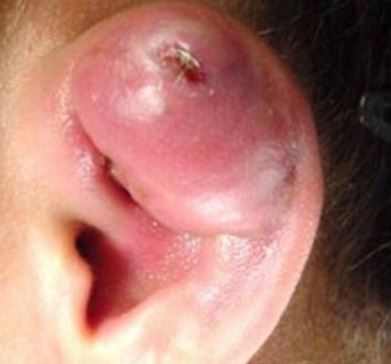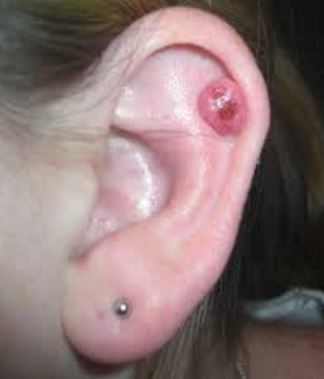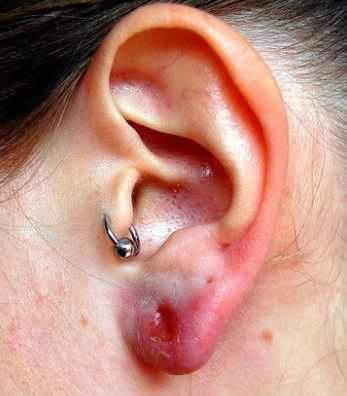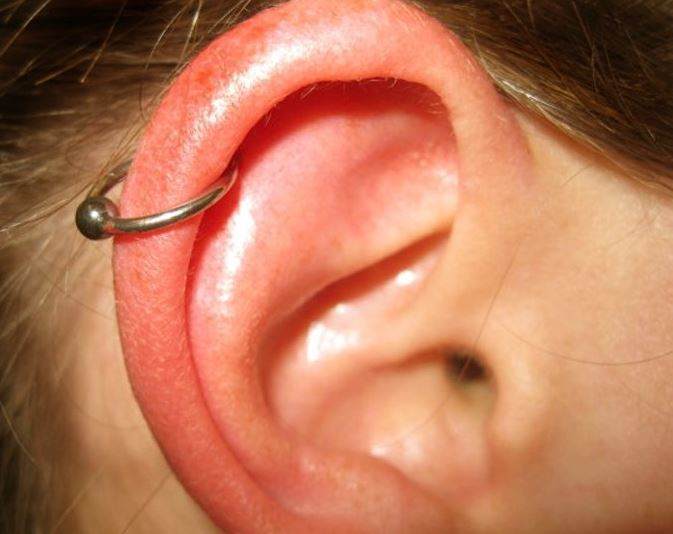An infected cartilage piercing may have a bump, abscess or even drain pus. Without proper after care, cartilage piercings can easily get an infection. It is important to know the signs of infection and also learn how to care for, clean and treat the infection naturally at home. Here’s a guide to help you with that.
Often, the infection will take place when either the piercing is being made, or after it has been completed, and will often be caused by lack of proper care. When it does occur, there is a high probability that you will get allergy or infection symptoms.
Once you have had an ear piercing done, you should expect to experience a slight pain, and some swelling, which should last for a small duration. However, you should note that this is an argument that is primarily based on the equipment that has been used, as well as the person who performed the cartilage piercing.
Infected Cartilage Piercing Signs & Symptoms
An infection of the cartilage is often caused by pathogens, which are known as Staphylococcus Aureus, as well as Pseudomonas Aeruginosa.
The following are some of the signs and symptoms you can expect to have when you have this kind of infection.
1. Redness
When your cartilage is infected, one of the major symptoms you can expect to have will be redness on the skin area surrounding your piercings.
Normally, the skin will turn red, or it could be a different color from the surrounding skin surface.
2. Pain
When the piercing becomes painful, or sensitive to the touch, this could be an indication that you have an infected cartilage piercing.
This is particularly when there are signs of aching or reddening around this area.
3. Oozing
Normally once you have your cartilages pierced, you can expect to see a white or pale yellow discharge. However, when you note a brown or greenish looking discharge, this will mean that something is not right.
It could mean that your recently pierced cartilage has become infected.
4. Bad Smell
An infected cartilage piercing will also exhibit signs such as bad smell coming from the cartilage.
In many cases, the bad smell will start emanating from the cartilage all on its own.
5. Fever and High Temperature
When the infection is severe, your body will start to experience a warm feeling, or have very high temperatures.
The warm feeling and the high temperatures can be noted every time you try to touch the area surrounding the recently pierced cartilage using your fingers.
It is something that poses a serious concern, and should not be ignored. If you note this symptom, it will be important for you to get immediate medical help from a GP, to prevent the occurrence of an ear infection, which could mean more bad news for your ear.
6. Bleeding
Bleeding is another serious concern that is exhibited by a cartilage that has recently become infected. Even though it is hard for bleeding to occur, you can expect it to take place when the infection is severe.
It is also normal for cartilage bleeding to take place after you have had a severe injury which exposed your ear to an infection.
The above symptoms aside, additional symptoms will include migration or rejection, which basically means that the cartilage piercing has moved from the initial spot, and headed to a new location.
My Cartilage Piercing Is Infected —Causes
According to Dr. Axe, cartilage piercing infection is primarily caused by microorganisms of the Pseudomonas aeruginosa and Staphylococcus Aureus. It is normal for many people to experience the symptoms after they have had their cartilages pierced, but it is also normal for the infection to occur during the piercing process.
So what causes an infection to occur?
1. Use Of Poor Piercing Equipment Or Unprofessional Piercing
Before you get any piercing done on your body, one of the most important factors to consider will be sterilization.
When piercing any part of your body, the equipment in use will be coming into contact with your blood supply.
Even though there are people who will argue that piercing guns cause less pain, there is a need to understand that any external object that is exposed to your blood supply is likely to cause problems.
When piercing the cartilage, the piercing gun will force a stud through the skin surface, and this will cause the skin to rip for it to make room for the jewelry, thus exposes it to trauma, and the chances of getting an infected cartilage piercing.
2. Constant Touching

It is common for many people to ignore this factor, but it is the most prevalent cause of an infection.
As noted above, infected piercings are caused by pathogens. The majority of these pathogens can be found living freely on your skin surface. Therefore, when you constantly touch the jewelry that has recently been introduced to the skin with hands that are not clean, you make it possible for the pathogens to gain access to your body.
Therefore, it should not appear as a shocker when your GP informs you that the cartilage has become infected, months, or years after the piercing has completely healed.
3. Poor Personal Hygiene
When you do not maintain high levels of personal hygiene, you increase your chances of getting infected.
What happens is that the infection will spread from the cartilage and on to other parts of your body through direct touching, or by coming into contact with this jewelry.
For example, when you have long hair but do not take precautions to clean the hair regularly, it becomes a hot spot for harboring bacteria and fungus.
4. Using Inappropriate or Cheap Jewelry
When you get your cartilage pierced, you will need to make sure that you make use of the right jewelry.
Using cheap studs, or studs made from nickel enhances your chances of getting infected through contact allergy.
When you have an allergic reaction, it means that bumps will begin to form due to this reaction. The presence of the bumps on your skin surface will mean that you are likely to get an infection because of constant touching, or because of irritation.
Cartilage Piercing Cleaning and Aftercare Tips
It is often common to find people asking how they should go about treating a cartilage that has recently been pierced
When you get your ear pierced, you will often be satisfied when you see this piercing begin to heal quickly, and without having to endure much pain, or swelling.
When a professional has done the piercing, the aftercare procedure should be straightforward
You should follow these when it comes to dealing with a cartilage piercing
1. Saline Cleaning and Warm Water
The best way to take care of a cartilage piercing is by properly cleaning the area. You can go about this process by using warm water once you have taken a shower using hair shampoo.
Warm water is vital as it helps in relieving the pain caused by the piercing, while at the same time relieving any swelling that could be present.
Additionally, cleaning will also play an important role in promoting healing, as it will discourage microbes from accumulating on the surface near the piercing.
Using a saline solution to perform the cleaning will also guarantee better relief, especially when this piercing hurts. Saline solutions have also been known to help in accelerating the healing process of the piercing.
However, it is imperative to note that there are cleaning solutions which can cause terrible results when used on new or piercings that are just starting to heal.
2. Warm Sea Salt Soaks
At times, an infected ear piercing bump can appear at the top, or back of your ear. If this does happen, you will need to prepare a solution using the following process.
Directions
- Boil four glasses of water and pour two glasses into a bowl, before adding a quarter spoonful of table salt
- Proceed to stir it as you allow it to cool down
You will need to use a very soft material, such as cotton when you are applying the solution. Ensure you repeat this procedure two times each day
3. Avoid Touching
Unless it is mandatory for you to touch the ear, especially when you are cleaning, you should not touch a recently piercing cartilage.
If you have to change the studs, make sure first thoroughly to cleanse your hands, and rinse the entire set of tools that you will be using when transferring these items, to ensure that you do not transfer infection causing microbes to the jewelry holes.
It is also recommended that you allow both hands enough time to dry before you can start the jewelry changing procedure.
You should, however, note that you will not be expected to change the jewelry often once the healing process has started.
4. Stay Away From Smoke, Or Avoid Smoking
It is very important to ensure that you stay away from environments that are smoky. Some can cause a lot of irritation to a new cartilage piercing
5. Do Not Change The Jewelry Often
You must ensure that you do not change the jewelry often unless there is a problem with the suds that were used before.
If any complications happen, you will have to go back to the person who pierced the cartilage for assistance
6. Use Fitting Jewelry
You must always ensure that you do not insert any other type of jewelry unless the recommended jewelry into the ear
One of the crucial aftercare tips to prevent an infected cartilage piercing is the use of recommended jewelry, as this helps make sure that you do not suffer from contact allergy, which may make the outer ear begin swelling.
What Causes a Cartilage Piercing Bump?

One of the primary reasons why the infected cartilage piercing has developed a bubble is because it was handled in a rough manner, and no aftercare was practiced at all.
Additional causes may include wearing jewelry made from incorrect materials, using materials that have not been sterilized, or incorrect handling by the professional performing the piercing.
The formation of a bump is often viewed as part of the healing process associated with cartilage piercings. When you practice proper aftercare, it may be possible for you to avoid it all together.
Care Tips to Heal Cartilage Piercing Infection
1. Visit a Doctor
It is important not to take an infected cartilage piercing lightly. If left untreated, the infection may spread very fast, leading to extensive damage taking place on your ear cartilage.
When you visit a GP because of cartilage infection, the first thing they will do will be to request for a culture test, which is determined to establish whether there is a presence of microorganisms in the cartilage or not.
Once the tests have been carried out, if the doctor establishes that this infection was caused by a bacterial infection, there is a chance that he may recommend you consume antibiotics for between ten and fourteen days.
In case he notes that it is a minor infection, he will provide you with home remedies; you can use to care for the infection and ensure that your cartilage heals properly.
2. Always Wash Your Hands
Although this is common knowledge when dealing with piercings on the body, many people rarely follow this advice.
When you fiddle with the cartilage piercing without having washed your hands, you increase the chances of transmitting germs that can cause an infection to the piercing.
You, therefore need to ensure that you always wash your hands using a liquid antibacterial soap, accompanied by hot water to ensure that you will not get an infected cartilage piercing.
3. Use Saline Solutions When Cleaning the Area
Saline solutions are the best home remedies when it comes to dealing with an infected cartilage piercing.
Even though the saline solution will not be able to kill any bacteria that is present, it helps keep the bacteria at minimum levels, in such a way that the body will be able to control how they spread.
Directions
You will need:
- A single shot of distilled warm water
- A quarter teaspoon of table salt
Procedure to prepare:
- obtain all these ingredients and combine them in a saucepan that has a lid
- Allow it to boil for at least fifteen minutes
- Once the saline solution has cooled down, you will need to use a cotton swab in cleaning the piercing area
4. Tea Tree Oil
When it comes to readily available home remedies, tea tree oil is a very good ingredient that can be used to treat infected piercings.
The oil will work by damaging or weakening the germs that are found on the outer covering, making it possible for the immune system to eliminate them easily.
We highly recommend Essential Oil Labs Tea Tree Oil (Check price on Amazon)
Additionally, tea tree oil also happens to contain antifungal properties, as well as mild tissue regenerators.
A majority of the tea tree oil products that are commercially available normally have concentrations that range between two and five percent. Ensure you do not use a product that has a concentration higher than this as it may produce side effects, which may include severe allergic reactions.
You must, therefore, ensure that you dilute the tea tree oil with an essential oil such as coconut oil
5. Chamomile Tea
When Chamomile tea is used topically, it plays an important role in helping reduce the pain experienced by the body given that it contains important anti-inflammatory properties.
Chamomile is preferred because it is able to seep through the skin layers, and this makes it possible for it to perform the intended tasks.
For you to use it in the infected area, you need to blend chamomile tea bags with a pot of freshly boiled water.
Once it is blended, leave it for three minutes before proceeding to strain it. It should be left to cool down a few minutes, before immersing a ball of fresh cotton to the solution, for use in applying the solution to area that is infected.
6. Aloe Vera Gel
Aloe Vera has been known to work in three ways when it comes to helping you deal with an infection arising from an infected piercing.
One, Aloe Vera is capable of reducing inflammation due to the fact that it contains anti-inflammatory properties. Secondly, it is able to fight off bacteria, including the strains that are often resistant to antibiotics, and lastly, the gel promotes healing of the cartilage.
We highly recommend organic cold pressed Aloe Vera gel (Check price on Amazon)
You can purchase aloe Vera as cream or gel from any pharmacy. Additionally, you may choose to harvest your own gel from the leaf.
Once harvested, you can proceed to apply it directly to the area that is affected, without encountering any side effects. You should, however, make certain that you do not use the gel on wounds that are open or deep.
7. Witch Hazel
The witch hazel is considered to be a very versatile plant. It has often been used by traditional healers for a number of purposes such as stopping bleeding, reducing swelling, killing harmful germs as well as treating wounds.
It is, therefore, a perfect remedy for use in treating a cartilage infection as it has the ability to constrict your blood vessels, form a partial wall against any form of infection, and at the same time draw your tissues together.
The wall is meant to make it possible for the wounds and burns to heal as required. When looking for witch hazel, you will find that there are a variety of preparations available in the market which range from extracts, ointments, tincture, to gels.
8. Comfrey
According to WebMD, clinical trials have shown that comfrey can be an effective, and safe topical medicine that can be used for conditions that deal with pain, swelling, as well as inflammation.
Comfrey contains an ingredient known as allantoin, which helps in speeding up the wound healing process, as it encourages the development of new cells, and in the process controls the body’s inflammatory response.
Ensure you do not take any comfrey preparation orally, or apply it on the skin of a small child. It is for that explanation recommended that one only use creams and ointments when it comes to treating the infected cartilage.
9. Lavender
Lavender, once it has been diluted is known to be both soothing and calming. Additionally, it is a good remedy for use when dealing with insect bites, scrapes as well as infected cartilages.
According to the University of Maryland Medical Center, you should use two drops of lavender oil, for each drop of essential oil used. Before you can proceed to apply it to the area that is infected, you will first need to apply it to the inner forearm. Allow it at least twenty-four hours to check whether you will have an allergic reaction or not.
How to Avoid an illness When You Have a Cartilage Piercing
Even though it is possible to treat a cartilage infection, prevention is always best. You can prevent your cartilage from getting infected by doing the following:
- Ensuring you change your jewelry
- Avoid public pools, lakes, and oceans
- Avoid wearing hats, or clothes that are not clean. If you really need to wear a hat, ensure that you wash the hat on a frequent basis
- Make it a point to regularly change your bedding. Dirty blankets, pillow cases or sheets could be the source of an infection.
- Ensure you take off your jewelry once every three weeks
- Avoid placing cell phones near the piercing
- When you suspect that you could have an infection, ensure you seek medical help from a GP or the person who performed the piercing
- Stay away from hair styling products like sprays and foams
- Do not use alcohol when you are treating the jewelry as any residue may end up irritating the infection
All the above-listed methods will help you take care of an infected cartilage infection. It is always recommended to ensure that one seeks help with the infection when the symptoms become severe, or when the home remedies are unable to eliminate the symptoms.
References;
- http://www.epainassist.com/earache-or-ear-pain/ear-piercing-infection-causes-treatment-home-remedies-preventive-measures
- http://www.newhealthadvisor.com/cartilage-piercing-bump.html
- http://www.healcure.org/ear/cartilage-piercing/cartilage-piercing-infection-causes-signs-bump-how-to-treat-clean-it/




